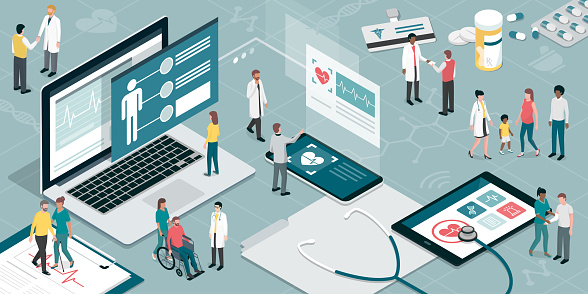
Healthcare challenges over the last decade have driven healthcare organizations to adopt new methods that allow them to operate while minimizing the risk of contamination among physicians, patients and hospital staff. These methods accelerated telemedicine adoption and healthcare organizations continue to benefit from the advantages of this technology.
However, while most people in healthcare are familiar with telemedicine, some may not be as familiar with Virtual Desktop Infrastructure (VDI) and how the two go hand in hand so well. VDI is a technological solution wherein virtual applications, virtual desktops and data are hosted in a datacenter or a cloud infrastructure and then delivered remotely to endpoint devices like laptops, PCs, tablets, thin clients, and smartphones.
We’ve made great strides in the healthcare space, particularly in empowering organizations to adapt swiftly in a post-pandemic world. We’ve seen that, for healthcare organizations specifically, it is crucial to access tools, like electronic health record (EHR) applications and prescription services from anywhere. Healthcare organizations are looking for help in providing their employees and customers with secure remote access to critical tools and prescription services.
Telemedicine and VDI go hand in hand
When people hear the word “telemedicine,” they likely think of an off-site physician conducting a video conference with a patient. Although video conferencing tools are a staple in telemedicine, they are not the only tools used. In reality, most remote healthcare practitioners often also need access to software applications such as for EHR and other medical databases, medical diagnostics, medical imaging, medical billing and hospital management solutions, among others.
While some of these tools can be installed on a remote worker’s personal laptop or desktop, most of those devices aren’t designed for that. In addition, doing so would mean storing sensitive patient or financial data on personal employee devices. This would put organizations at risk of a data breach and, in some places, violate data protection laws like the U.S. Health Insurance Portability and Accountability Act (HIPAA).
Furthermore, tech-savvy medical practitioners might be more inclined to use mobile devices such as smartphones and tablets, and thus prefer to access those software tools from there. Unfortunately, almost all the medical tools and applications mentioned earlier aren’t designed for that.
This is where VDI can come in handy as it can make it possible for remote healthcare practitioners to access the applications they need from their device of choice the moment they need to. And because data isn’t stored on the devices themselves, they can do so without compromising data security.
Essentially, the more healthcare organizations engage in telemedicine, the more practical VDI usage becomes for those organizations.
Accelerated adoption of telemedicine and VDI
As we all saw Covid-19 infections surge a few years ago, healthcare facilities grappled with the overwhelming influx of patients. To minimize transmissions in hospital premises, some hospital staff were asked to work remotely whenever possible.
The effective combination of telemedicine and VDI allows doctors to continue providing health services during critical times while avoiding direct contact and minimizing the risk of contamination. With most of their time and resources devoted to serving the rapidly rising number of cases, healthcare organizations may wish to consider being more circumspect in their choice of telemedicine and/or VDI solutions. Solutions that are overly expensive can siphon too many resources, and those that are highly complex can take too much effort and time to deploy.
VDI solutions with a simplified architecture eliminate the need for healthcare organizations to send out IT staff for training, hire expensive third-party specialists and/or wait weeks or months before deploying desktops and applications. Instead, desktops and applications can be delivered to remote physicians and hospital staff within hours or days, ensuring prompt resumption of medical services. These factors translate to a much lower Total Cost of Ownership (TCO), giving healthcare organizations the financial flexibility they may need for prioritizing other essentials, which include hiring more healthcare workers, stocking up on PPEs and procuring critical medical equipment such as artificial respirators, ventilators, etc.
Reinforcing healthcare IT initiatives with VDI
Many healthcare organizations have long implemented remote-work options based upon guidelines from the World Health Organization and local government recommendations to minimize the spread of infectious diseases. These initiatives are mainly focused on the following key areas:
- Construction a cyber security support model
- Establishing fast and secure authentication
- Leveraging VDI for primary care
Let’s take a closer look at each.
Cyber security support model
For more than 10 straight years, healthcare has had the highest average data breach cost among all industries. The increased adoption of digital workflows and remote work in the last few years have broadened the attack landscape of healthcare organizations’ IT systems, leaving them more exposed to data breaches and other cyber incidents. VDI can help organizations reinforce these initiatives though a robust stack of security functions that include SSL/TLS data-in-motion encryption, multi-factor authentication, advanced filtering, FIPS 140-2 encryption and more, all of which secure the delivery of virtual applications, desktops and data to end user devices.
Fast and security authentication with single-sign-on
In the medical field, prompt delivery of patient care is paramount. Unfortunately, medical staff are often bogged down by the incessant need to login to multiple systems. Some VDI solutions address this by making all applications accessible on a single device and authenticating users through fast, SSO-enabled logins. SSO makes it possible for medical staff to login just once to access all the applications they need for the entire shift. In addition, some VDI solutions have Artificial Intelligence (AI)-based session pre-launch functionality that cuts down log times significantly by analyzing user login habits and then pre-launching sessions based on those habits.
Leveraging VDI for primary care
Forward-thinking healthcare organizations have started rolling out virtual desktop initiatives that would enable healthcare staff to work remotely through a Bring Your Own Device (BYOD) arrangement. VDI excels in supporting BYOD environments through its ability to deliver practically any application (even legacy applications) to any endpoint device. VDI also offers great user experiences on touch screen devices with their ability to support native touch gestures, like swipe, drag, tap-to-click and zoom in, all of which enable medical practitioners to work more efficiently on their phone or tablet.
Conclusion
Healthcare organizations are currently facing one of the most challenging periods in their existence. Now, more than ever, they must strive to innovate to ensure continuous patient care delivery while keeping medical staff safe. The good news is that the technology is available to healthcare organizations so that they can offer this level of care. With its ability to provide secure, reliable and fast remote application delivery to any device, VDI can significantly help healthcare organizations in these endeavors so they can focus on their number one priority – providing care to patients in need.
Photo: elenabs, Getty Images
Prashant Ketkar is Chief Technology Officer, Parallels. He leads Parallels’ product and engineering operations that drive the continuous evolution and transformation of the product portfolio. He previously served as Senior Vice President (SVP) of Product & Engineering at Resolve Systems and as Entrepreneur in Residence (EIR) at Madrona Venture Labs where he incubated ideas in the robotic process automation space. He also served as SVP of Product at Evident.io until the company's acquisition by Palo Alto Networks in 2018. Prashant served as VP of Development at Oracle, setting up the company's Seattle R&D operations and heading its public cloud infrastructure efforts, and was an early product lead for Azure at Microsoft where he was responsible for core infrastructure services leading to Azure's launch in 2009. Prashant has a bachelor's degree in Electronics Engineering from the University of Mumbai and an MBA from the Asian Institute of Management.
This post appears through the MedCity Influencers program. Anyone can publish their perspective on business and innovation in healthcare on MedCity News through MedCity Influencers. Click here to find out how.











